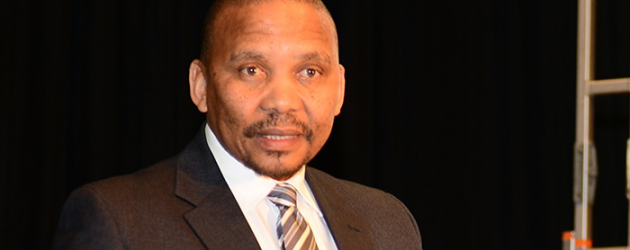Inkosi Sango Patekile Holomisa, Deputy Minister of the Department of Labour.
The 109th annual Master Builders South Africa (MBSA) conference was held last month at the Boardwalk Hotel and Convention Centre in Port Elizabeth, with the theme ‘Building a Sustainable South Africa’, addressing topics like skills development, growth and job creation in the building and construction industry.
Sub-themes included education, the state of the local economy, job creation and future prospects for the industry and the country.
MBSA president, Colin Cozens, opened the congress, telling delegates that to achieve sustainability, SA needs an all-inclusive building industry.
“We simply cannot leave out previously marginalised parties as has happened in the past. The industry needs to transform more quickly than before and we need to win back government’s trust, which has been eroded with the recent collusive tendering,” he said.
“It is my opinion that in the coming six to 12 months the flat growth of the economy is going to affect our industry even harder and if government wants a good opportunity to intensify the infrastructure spend, it is now. The building industry is the ideal platform to create jobs quickly and to transfer skills to the unemployed. It is times like we are experiencing now that the building industry needs government to be decisive and increase its spend in our industry and create desperately needed jobs.”
Some of the day’s highlights were the presentations made by Deputy Minister of the Department of Labour, Inkosi Sango Patekile Holomisa; Professor Jonathan Jansen, Vice Chancellor and Rector of the University of the Free State; Dr Azar Jammine, Director and Chief Economist of Econometrix and Clem Sunter, business author and scenario specialist.
Holomisa told delegates: “It is said that developing countries around the world such as Taiwan, Pakistan and the Philippines all report massive revenues, multiple projects and generally a boom in their construction industry. On the other hand, the contention is that SA is at pains to postpone projects thereby trying to prevent the industry from going bust.”
He said reasons for this included that SA is still trying to recover from the effects of the global recession; construction projects under way had to be cancelled due to rising costs; the increasing frequency of accidents and fatalities on construction sites; the lack of a skilled and experienced workforce.
In his talk Prof Jansen said: “One of the problems is that SA is facing a crisis but no one is aware of it, least of all the politicians. The schools only work for a third of our kids – and that is being generous. We have a vested interest from a social and economic point of view that all our children do well.”
He said that to change our schools we need to first put the basics in place, like putting roofs over learners’ heads, replace the pit toilets with decent toilets and make sure there is a textbook for every kid in every subject in every class.”
Dr Jammine examined the challenges facing SA’s economic prospects in the longer term, and Sunter spoke about global and local events that business must be aware of so they can adapt their behaviour ahead of their competitors.
On the second day of the conference, Dr Pierre Voges, chief executive of the Mandela Bay Development Agency (MBDA), discussed urban renewal in Port Elizabeth and Nelson Mandela Bay. He said that local economic development is failing in South Africa due to lack of sustainability and building a strong local economy needs to be driven by local people.
“As a result of the MBDA’s R500 million investment in urban renewal projects, business confidence has grown by 66 percent, new business sales to the tune of R548.1 million has been generated, 1 667 jobs have been created and there has been a R178.8m increase in additional GDP,” said Voges.
In his presentation, Eastern Cape Premier Phumulo Masualle said that since the mid 2000s, government has placed increasing emphasis on economic infrastructure such as ports, rails, dams and power stations.
“Over the past five years, investment in this infrastructure has dramatically increased. However, many challenges persist. Only 24 percent of the built environment professionals are black and only 9 percent are women. Projects still take far too long to complete. High profile cases of alleged overpricing in relation to leases and renovations of government properties where there is collusion with industry players needs to stop.”
He said the Expanded Public Works Programme aims to create six million work opportunities in the next five years. R30m will be invested to make public buildings more accessible to people with disabilities. Mud schools are to be eradicated as well as the bucket system. Enforcing the 30-day payments to service providers in the construction environment, the Construction Industry Development Board (CIDB) will this year develop regulations to ensure prompt payments to contractors and subcontractors.
Mninawa Ngcobo, training manager at the National Home Builder Registration Council, said the construction industry remains key to supporting the country’s infrastructural development requirements despite the financial challenges of the previous years.
“The government’s infrastructure development plan and the ‘new’ Presidential Infrastructure Coordinating Commission are positive signs for future growth in the industry. However, the current reality is indicating that shortage of skills supply and the increasing unemployment figures remain pressing concerns in the current South African economy and the built environment is no exception.”
Thabo Masombuka, chief executive of the Construction Sector Charter Council, told delegates that BEE shouldn’t be a compliance issue - it should be a way of doing business.
“In October 2013, the Department of Trade and Industry (DTI) gazetted and published a set of revised Codes of Good Practice and gave industry until the end of April 2015 to align and comply. All sector codes must be aligned by this time. Workshops are underway to discuss the five elements and once meetings have been held we need to be ready to submit the new look Construction Sector Code by October 30, 2014,” he said.
The 110th annual MBSA Congress will take place in Johannesburg in 2015.
There are divers treatment options for numerous heartiness problems. Usually the remedies you searched for can more than one listing. Each listing is specific to each dose of drugs so it is significant that you select the appropriate version. There isn’t anything you can’t get on the Internet anymore. You can get remedy to treat acute treatment of the symptoms of rheumatoid arthritis or spasticity. Cialis is used to treat many types of medic problems. What about is there generic cialis and sexual life? What about sexual health and is there a generic for cialis? Erectile dysfunction, defined as the persistent inability to achieve a satisfactory erection, exerts an estimated more then twenty millions men in the America alone. Young men with sexual dysfunctions need occupational help. Ordinarily in this situation, cognitive behavioral therapy is the treatment used. Why it happen? How common is erectile dysfunction? Unfortunately nearly all recipe drugs have sometimes objectionable aftereffects, from headache to death. No doubts you need to take undesirable side effects in consideration before purchasing the remedy. Follow all directions on your prescription label.


